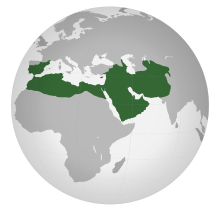Yazid III
| Yazid ibn Walid | |||||
|---|---|---|---|---|---|
| Caliph of the Umayyad Caliphate | |||||
| Reign | 17 April 744— 4 October 744 | ||||
| Predecessor | Walid ibn Yazid | ||||
| Successor | Ibrahim ibn al-Walid | ||||
| Born | 701 | ||||
| Died | 4 October 744 (aged 43) | ||||
| |||||
| Dynasty | Umayyad, Marwanid branch | ||||
Yazid ibn al-Walid ibn 'Abd al-Malik or Yazid III (701 – 25 September 744) (Arabic: يزيد بن الوليد بن عبد الملك) was an Umayyad caliph. He reigned for six months, from April 15 to October 3 or 4, 744, and died in that office.
Yazid was the son of a Persian princess who had been given as a concubine to Caliph al-Walid I.[1] Al-Tabari quotes a couplet of Yazid's on his own ancestry:[2]
- I am the son of Chosroes, my ancestor was Marwan,
- Caesar was my grandsire and my grandsire was Khagan.[3]
Tabari further records descriptions of Yazid as being tall and handsome.
During the reign of his cousin al-Walid II, Yazid spoke out against Walid's "immorality" which included discrimination on behalf of the Banu Qays Arabs against Yemenis and non-Arab Muslims, and Yazid received further support from the Qadariya and Murji'iya (believers in human free will).[4] Yazid slipped into Damascus and deposed Walid in a coup, following this up with a disbursement of funds from the treasury.[5]
According to Yazid's own account, Yazid sent Abd al-Aziz ibn al-Hajjaj to meet Walid at al-Bakhra'.[6] 'Abd al-Aziz offered to set up a tribal assembly (shura) to decide the future of the realm. Walid rejected this offer and attacked, by which action he lost his life.[7] Yazid had Walid's head hoisted "on a lance and paraded around Damascus"; Yazid then imprisoned Walid's sons 'Uthman and Hakam,[8] whom Walid had designated as his heirs.[9]

On accession, Yazid explained that he had rebelled on behalf of the Book of Allah and the Sunna of His Prophet, and that this entailed ensuring that the strong not prey upon the weak. He promised "to engage in no building works, squander no money on wives or children, transfer no money from one province to another" without reason, "keep no troops on the field too long", and not to overtax the ahl al-dhimma; instead, he would eschew discrimination and would make his payments on time. He promised abdication if he failed to meet these goals, and held in principle to al-amr shura - to an elected caliphate.[11]
Tabari records Yazid's nickname "the Diminisher (Naqis)", given because he reduced military annuities by 10%,[12] whereas his predecessor had promised a raise. According to Islamic popular tradition, recorded in an apocalyptic style, Yazid would go himself into the marketplace.[13]
The city of Hims refused allegiance to Yazid, and there were several other dissident movements against him.[14] Another cousin, Marwan ibn Muhammad ibn Marwan, governor of Armenia, had initially supported Walid and on Walid's death entered Iraq to avenge him.[15] Marwan eventually rallied around Yazid.
Yazid appointed Mansur ibn Jumhur to replace Yusuf ibn 'Umar as governor of Iraq. On May 15, Yazid wrote a letter, preserved from oral sources in al-Mada'ini (reproduced in Tabari) and in al-Baladhuri. It supports the Umayyad dynasty up to but not including "the enemy of Allah" al-Walid II, at which point it lays out Yazid's version of the event at al-Bakhra'. At the end, Tabari's rendition has Yazid exhorting the Iraqis to follow Mansur ibn Jumhur.[16]
Yusuf ibn 'Umar was subsequently imprisoned and later killed by the son of Khalid ibn 'Abdallah al-Qasri. Mansur attempted to dismiss the Khurasani governor Nasr ibn Sayyar, but Nasr refused to accept this. Facing opposition from Juday al-Kirmani, Nasr invited al-Harith ibn Surayj to return from his thirteen-year stay in Turgesh territory. Al-Harith arrived wearing a fine suit of armour the Khaqan had given him and gained the support of many people in Khurasan.
Yazid named his brother Ibrahim as his successor. Yazid fell ill of a brain tumour[17] and died on October 3 or 4, 744. Ibrahim duly succeeded him.
Bibliography
- ↑ Philip Khuri Hitti, History Of Syria (Gorgias Press LLC, 2004), 489
- ↑ Tabari, 243
- ↑ transl. Sir John Glubb, The Empire of the Arabs, 200
- ↑ von Ess, "Kadar", Encyclopedia of Islam 2nd Ed.
- ↑ Theophilus. Quoted Robert Hoyland, Seeing Islam as Others Saw It (Darwin Press, 1998), 660
- ↑ 1234 Chronicle apud Hoyland confirms this, 660; it was a fortress near Palmyra. 1234 and Muslim sources dispute over whether Walid was there all along or whether he had fled there.
- ↑ Patricia Crone, God's Caliph (Cambridge U Press, 1986), 127
- ↑ Theophilus and Muslim sources apud Hoyland, 660-1
- ↑ God's Caliph 124-5
- ↑ "Inscribed Pound Weight". The Walters Art Museum.
- ↑ God's Caliph, 68, 107
- ↑ Philip Khuri Hitti, 478
- ↑ David Cook, Studies in Muslim Apocalyptic, 350: appendix I, III, 12 a
- ↑ 1234 Chronicle apud Hoyland, 661
- ↑ Theophilus apud Hoyland, 661
- ↑ God's Caliph, 126f
- ↑ Dionysius of Telmahre apud Hoyland, 661 n 193
- Muhammad ibn Jarir al-Tabari History, v. 26 "The Waning of the Umayyad Caliphate," transl. Carole Hillenbrand, SUNY, Albany, 1989
- Sir John Glubb, The Empire of the Arabs, Hodder and Stoughton, London, 1963
| Yazid III Born: 701 Died: October 3 or 4, 744 | ||
| Sunni Islam titles | ||
|---|---|---|
| Preceded by Walid ibn Yazid |
Caliph of Islam Umayyad Caliph April 15 to October 3 or 4, 744 |
Succeeded by Ibrahim ibn al-Walid |
